Whether you would like to learn more about shark cage diving, or you are seeking resources on a specific shark or marine species, Apex Shark Expeditions offers a range of information on sharks and marine life found in South Africa. For nature enthusiasts wanting to expand their knowledge, students seeking information for assignments or those who simply have an interest in sharks and the many other species that share their underwater world, our information guides give you everything you ever wish to know about sharks, , dolphin, whales, pelagic birds, game fish and so much more.
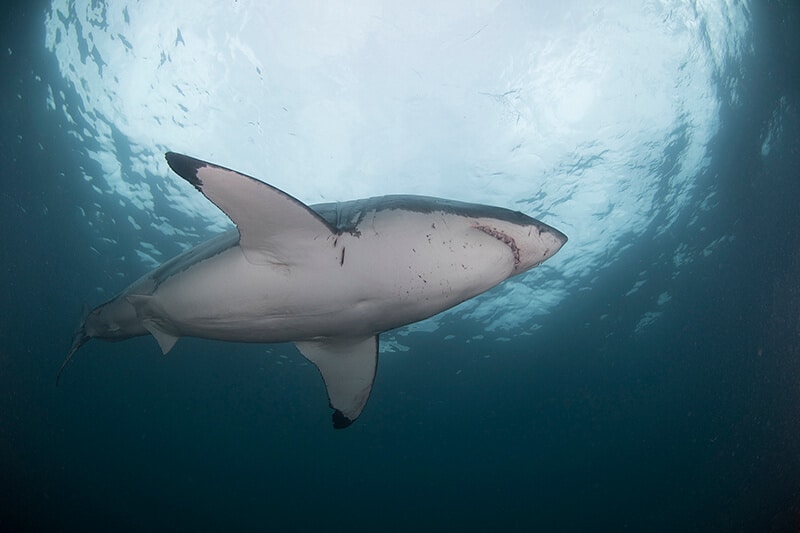 During months of February to September the Great white sharks congregate around Seal Island in False Bay. Seal Island is the largest island based seal colony in Africa and is home to 60,000 Cape fur seals. This is the winter hunting ground of the Great white shark and the 6 month old pups from this seal colony make up the bulk of their winter diet.
At 6 months the young seals are weaned off their mothers and when they venture out to feed on their own for the first few times they are at their most vulnerable to the Great white sharks who specifically target this size seal. During a season we can observe up to 800 predatory events making it the most intense Great white shark hunting area known on earth.
The presence of large numbers of Great white sharks makes for excellent sightings of sharks around the boat and cage diving.
Once the spring and summer South East wind starts to blow warm water currents enter False Bay bringing with it an entire eco system. The strong winds and churned up waters stimulate an algal bloom which supports various baitfish in the Bay.
The baitfish in turn attracts migratory fish species such as Kabbeljou, Yellow tail, Elf and Steenbras which in turn attracts larger predators.
If is not uncommon to find high numbers of Bronze Whaler sharks just behind the surf line as well as the occasional Ragged tooth and common Thresher shark. Although the population of Smooth hound sharks are dwindling due to over fishing this species is also present in the inshore False Bay area. All of these species make up the summer diet of the Great white shark and are largely the result of the movement from Seal Island to the inshore areas along False Bay’s coastline during the summer months.
During months of February to September the Great white sharks congregate around Seal Island in False Bay. Seal Island is the largest island based seal colony in Africa and is home to 60,000 Cape fur seals. This is the winter hunting ground of the Great white shark and the 6 month old pups from this seal colony make up the bulk of their winter diet.
At 6 months the young seals are weaned off their mothers and when they venture out to feed on their own for the first few times they are at their most vulnerable to the Great white sharks who specifically target this size seal. During a season we can observe up to 800 predatory events making it the most intense Great white shark hunting area known on earth.
The presence of large numbers of Great white sharks makes for excellent sightings of sharks around the boat and cage diving.
Once the spring and summer South East wind starts to blow warm water currents enter False Bay bringing with it an entire eco system. The strong winds and churned up waters stimulate an algal bloom which supports various baitfish in the Bay.
The baitfish in turn attracts migratory fish species such as Kabbeljou, Yellow tail, Elf and Steenbras which in turn attracts larger predators.
If is not uncommon to find high numbers of Bronze Whaler sharks just behind the surf line as well as the occasional Ragged tooth and common Thresher shark. Although the population of Smooth hound sharks are dwindling due to over fishing this species is also present in the inshore False Bay area. All of these species make up the summer diet of the Great white shark and are largely the result of the movement from Seal Island to the inshore areas along False Bay’s coastline during the summer months. 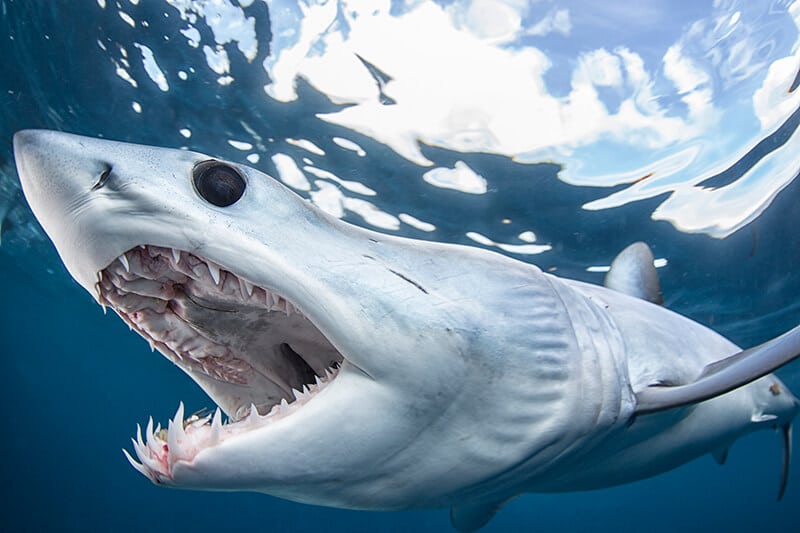 The Mako is the perfect shark. Royal blue on top and silvery white below it is the most beautifully proportioned the fastest, the most strikingly collared, and one of the meanest-looking animals on earth.
Like other mackerel sharks, the great white and the porbeagle, the Mako has a homocercal (equal-lobed) tail and a horizontally flattened keel at the tail’s base. They all are gracefully streamlined, with a conical snout, dark eyes, small second dorsal fins, and the aforementioned tail shape. The dark eyes give them the bold look of another group of superbly designed predators, the falcons. Mako’s start off feeding on bait fish but as they grow are capable of hunting large tuna’s, swordfish and even dolphin and seals.
Although capable of growing to over 4.0m (13ft) the Mako’s that we encounter are usually juveniles averaging about 1.5m (5ft) possibly using the area inshore of the Cape Canyons as a nursery ground. On rare occasions sharks of 7-9ft can be seen.
Sadly as everywhere that these spectacular sharks occur they are heavily fished for their meat and South Africa is now arguably the best spot on earth where during our high season you have an excellent chance to see these beautiful creatures.
The Mako is the perfect shark. Royal blue on top and silvery white below it is the most beautifully proportioned the fastest, the most strikingly collared, and one of the meanest-looking animals on earth.
Like other mackerel sharks, the great white and the porbeagle, the Mako has a homocercal (equal-lobed) tail and a horizontally flattened keel at the tail’s base. They all are gracefully streamlined, with a conical snout, dark eyes, small second dorsal fins, and the aforementioned tail shape. The dark eyes give them the bold look of another group of superbly designed predators, the falcons. Mako’s start off feeding on bait fish but as they grow are capable of hunting large tuna’s, swordfish and even dolphin and seals.
Although capable of growing to over 4.0m (13ft) the Mako’s that we encounter are usually juveniles averaging about 1.5m (5ft) possibly using the area inshore of the Cape Canyons as a nursery ground. On rare occasions sharks of 7-9ft can be seen.
Sadly as everywhere that these spectacular sharks occur they are heavily fished for their meat and South Africa is now arguably the best spot on earth where during our high season you have an excellent chance to see these beautiful creatures.  Sevengill sharks are the ancient undertakers of the sea. Growing to at least 10 feet these massive sharks with their disproportionately large heads filled with heavily serrated hexacomb cutting teeth are the dinosaurs of the deep. There are few places on earth where they occur in shallow water with reasonable visibility. Seal Island is one such venue and this is one of the great shark species we see from August to June at this famous Island that has been the subject of so many documentaries.
They are highly interactive around the cage ensuring guests enjoy excellent viewing opportunities and longer cage time.
Sevengill sharks are the ancient undertakers of the sea. Growing to at least 10 feet these massive sharks with their disproportionately large heads filled with heavily serrated hexacomb cutting teeth are the dinosaurs of the deep. There are few places on earth where they occur in shallow water with reasonable visibility. Seal Island is one such venue and this is one of the great shark species we see from August to June at this famous Island that has been the subject of so many documentaries.
They are highly interactive around the cage ensuring guests enjoy excellent viewing opportunities and longer cage time. 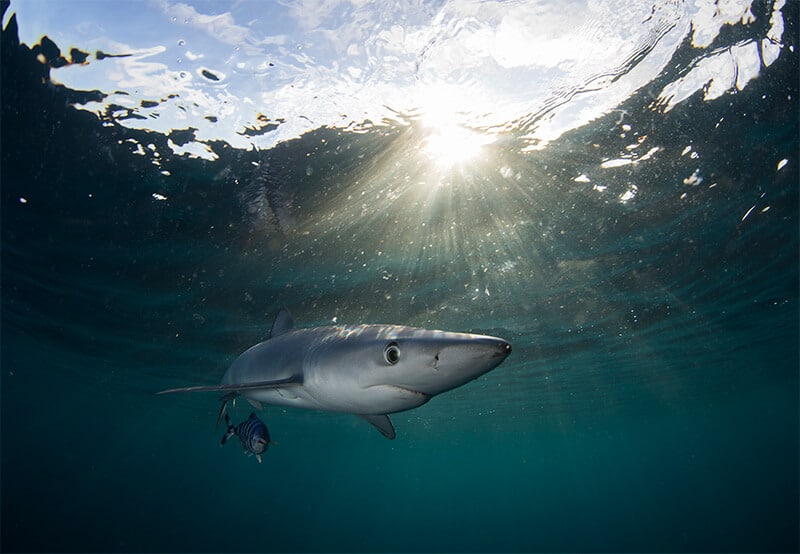 Sinuous in movement, the ever curious blue shark is one that will delight anyone wanting an in your face encounter with a shark.
As the name suggests these sharks are beautiful shades of blue in colour with long pectoral fins for gliding across the oceans whilst in search of food. Blue sharks undertake daily vertical up and down swim patterns as opposed to horizontal zigzagging as they search the water column for food, honing in on any scent that their intended meal leaves behind.
Also growing to 4.0m (13ft) in length the Blue shark is truly the nomad of the open ocean. Because food can be scarce in the open ocean, Blue sharks have an interesting adaptation in that they have papillose (finger-like) gill-rakers that very small food items such as krill, small squids and schooling fishes stops from escaping out the gill slits.
Sharks tagged by us off Cape Point have been recaptured off the Azores islands near Portugal. The Blue shark is one of the most fecund (giving birth to lots of young) of all large sharks with a mother once giving birth to 135 40cm young.
Blue sharks tolerate cooler water than Mako sharks and can often be found in good numbers in the cooler greener more nutrient rich water that lies just inside the warmer current lines.
Most Blue sharks we see are between 1.2m-1.6m (4-7ft) although at certain times of the year sharks of 6-9ft are seen. Sadly the Blue shark is heavily fished for its fins and more than 40 million are said to die annually. Most of these sharks are finned alive (as their meat spoils quickly and has little commercial value) and their still living carcasses are dumped back in the water. A sad way for an animal to die that is so curious and accepting of our intrusion into its world when we dive with them.
Sinuous in movement, the ever curious blue shark is one that will delight anyone wanting an in your face encounter with a shark.
As the name suggests these sharks are beautiful shades of blue in colour with long pectoral fins for gliding across the oceans whilst in search of food. Blue sharks undertake daily vertical up and down swim patterns as opposed to horizontal zigzagging as they search the water column for food, honing in on any scent that their intended meal leaves behind.
Also growing to 4.0m (13ft) in length the Blue shark is truly the nomad of the open ocean. Because food can be scarce in the open ocean, Blue sharks have an interesting adaptation in that they have papillose (finger-like) gill-rakers that very small food items such as krill, small squids and schooling fishes stops from escaping out the gill slits.
Sharks tagged by us off Cape Point have been recaptured off the Azores islands near Portugal. The Blue shark is one of the most fecund (giving birth to lots of young) of all large sharks with a mother once giving birth to 135 40cm young.
Blue sharks tolerate cooler water than Mako sharks and can often be found in good numbers in the cooler greener more nutrient rich water that lies just inside the warmer current lines.
Most Blue sharks we see are between 1.2m-1.6m (4-7ft) although at certain times of the year sharks of 6-9ft are seen. Sadly the Blue shark is heavily fished for its fins and more than 40 million are said to die annually. Most of these sharks are finned alive (as their meat spoils quickly and has little commercial value) and their still living carcasses are dumped back in the water. A sad way for an animal to die that is so curious and accepting of our intrusion into its world when we dive with them. While sharks play the biggest role at Apex, there are a number of other marine species inhabiting our rich coastlines in South Africa. Here is where you can discover everything you wish to know about a range of marine animals including dolphin, whales and game fish.
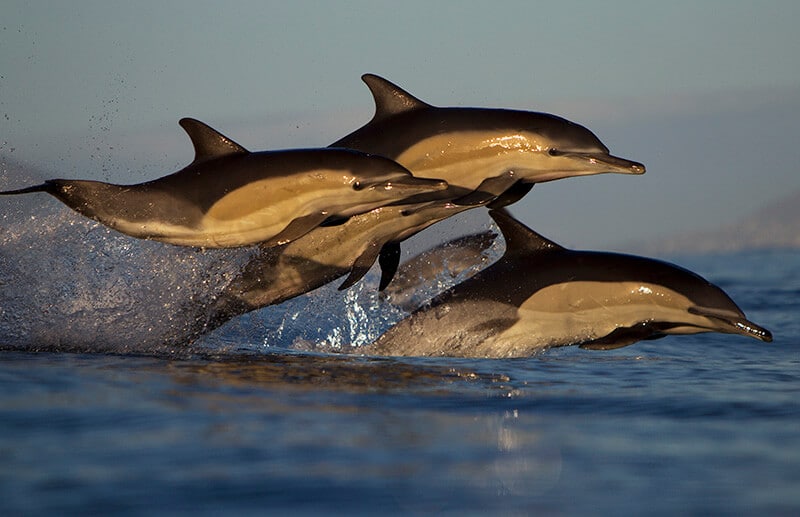 These beautifully patterned dolphin are especially common in False Bay in April but can be seen year round on about 20% of all of our expeditions. This species of dolphin grows to around 2.5 meter, lives close to 40 years and will actively race up to boats and try to ride the bow wave. Common dolphin can occur in mega schools of over 1000 animals but schools of 20-200 are more common. Look for the yellowish figure of 8 patterns on the flanks of this dolphin as a key identification feature. Common dolphins are distributed throughout tropical and warm temperate waters worldwide with surface temperatures of 10-28 degrees Celsius.
They are gregarious and group sizes may exceed 1000 animals. It is possible that larger groups are more effective at hunting in deep water. There may be a partial migration of this species further north in winter following sardine shoals. The groups can present different formations, some with fixed structures. Others may represent temporary aggregations for the immediate solution of a problem, like more efficient hunting or avoiding danger.
Males are larger and may reach 2.6 meter and females 2.3 meters. In the past, over 120 000 common dolphins were harvested in the Black Sea. Tomlin (1967) recorded aggregations of approx. 300 000 individuals. In SA waters common dolphins are often associated with flocks of Cape gannets. Pilchard, redeye herring and common squid formed the bulk of the diet.
The calf is born 800mm long after an 11 month gestation period. Calving peaks in summer. Lactation may last up to one and half years. Females are sexually mature at about 2 meter long when they are 6 to 7 years old. Calving interval is 3 years. Some fighting is assumed to occur between males due to competition for females. There are 51 pairs of teeth in the upper jaw and a similar amount in the lower jaw. Teeth are conical and 3mm in diameter. In a study of North Pacific common dolphins it was recorded that they moved 120kms in one direction during 24 hours. The average depth of a dive was 73m. The deepest dive recorded was 258m. Deep dives beyond 18m down only took place after sunset, when the acoustic deep scattering layer (a concentration of organisms that migrate vertically depending on ambient light conditions) rose towards the surface. The whale remora (Remora australis) may attach itself to common dolphin.
These beautifully patterned dolphin are especially common in False Bay in April but can be seen year round on about 20% of all of our expeditions. This species of dolphin grows to around 2.5 meter, lives close to 40 years and will actively race up to boats and try to ride the bow wave. Common dolphin can occur in mega schools of over 1000 animals but schools of 20-200 are more common. Look for the yellowish figure of 8 patterns on the flanks of this dolphin as a key identification feature. Common dolphins are distributed throughout tropical and warm temperate waters worldwide with surface temperatures of 10-28 degrees Celsius.
They are gregarious and group sizes may exceed 1000 animals. It is possible that larger groups are more effective at hunting in deep water. There may be a partial migration of this species further north in winter following sardine shoals. The groups can present different formations, some with fixed structures. Others may represent temporary aggregations for the immediate solution of a problem, like more efficient hunting or avoiding danger.
Males are larger and may reach 2.6 meter and females 2.3 meters. In the past, over 120 000 common dolphins were harvested in the Black Sea. Tomlin (1967) recorded aggregations of approx. 300 000 individuals. In SA waters common dolphins are often associated with flocks of Cape gannets. Pilchard, redeye herring and common squid formed the bulk of the diet.
The calf is born 800mm long after an 11 month gestation period. Calving peaks in summer. Lactation may last up to one and half years. Females are sexually mature at about 2 meter long when they are 6 to 7 years old. Calving interval is 3 years. Some fighting is assumed to occur between males due to competition for females. There are 51 pairs of teeth in the upper jaw and a similar amount in the lower jaw. Teeth are conical and 3mm in diameter. In a study of North Pacific common dolphins it was recorded that they moved 120kms in one direction during 24 hours. The average depth of a dive was 73m. The deepest dive recorded was 258m. Deep dives beyond 18m down only took place after sunset, when the acoustic deep scattering layer (a concentration of organisms that migrate vertically depending on ambient light conditions) rose towards the surface. The whale remora (Remora australis) may attach itself to common dolphin. Lagenorhynchus obscurus
These dolphin are only seen a handful of times each year. They are 1.5 to 1.8 meters in length and are mostly black and white. They are a lot smaller than common dolphins and occur typically in schools numbering 10-50 animals although we have on two occasions seen schools of over 500 animals. The maximum age is believed to be around 35 years. The sighting of this species is often made more special by their playful acrobatic antics.
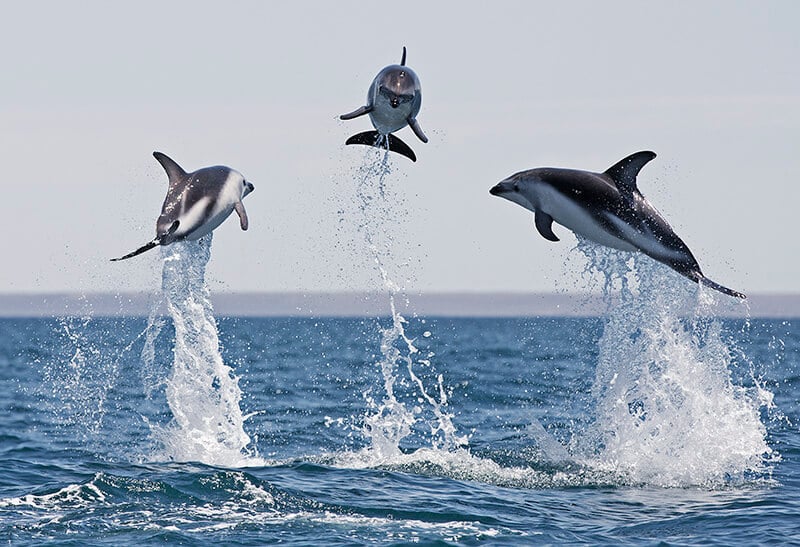
Tursiops truncates & Tursiops aduncus
We have seen two species of bottlenose dolphin in False Bay. Mostly seen closer towards Muizenberg and Strandfontein beaches, these 2,5 meter grey dolphins typically dive for lengthy periods and often swim in tight groupings. On very rare occasions these dolphins will swim right next to Seal Island. This species of dolphin has on several occasions been found inside the stomachs of Great white sharks. Interestingly the male Indo Pacific bottlenose dolphin eats larger prey than the female.
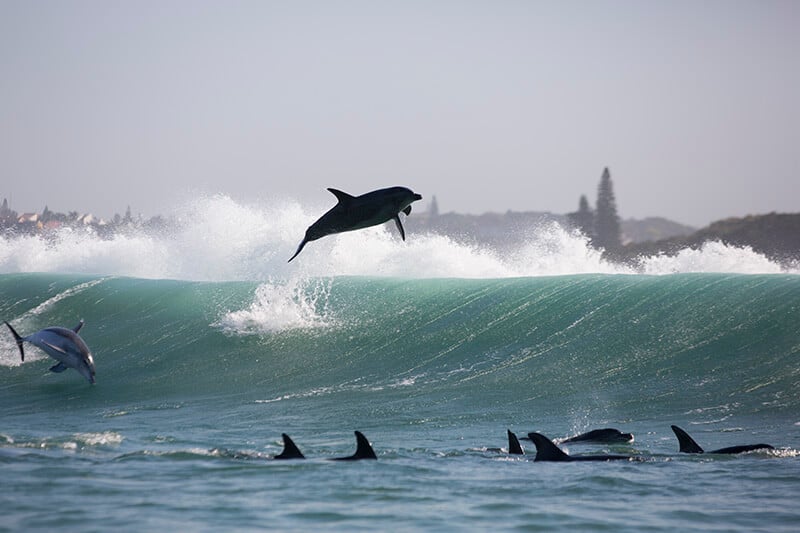
Sousa chinensis
Humpback dolphin have only been seen a handful of times ever in False Bay and we have been lucky enough to see them twice. They are between 2.5 to 2.8 meters and are characterized by an irregular hump shaped dorsal fin and on both occasions where we have sighted these animals they have been seen close inshore. Sadly in the inshore South African population large levels of pollutants have been found in their tissue.
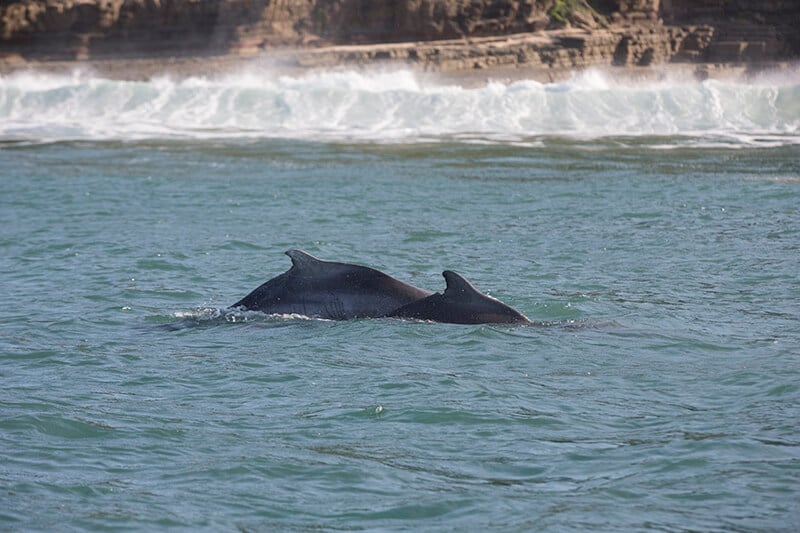
 Although seldom seen elsewhere, these 15 meter long whales are semi resident in False Bay. They are often seen in areas where shoals of bait fish such as sardines and anchovies occur and occasionally can be seen gulp feeding.
They are identified by a small curved dorsal fin two thirds of the way along the back of the whale. On rare occasions this species can be seen lunge feeding into shoals of bait fish. They can be distinguished from other small finned whales by the presence of three grooves on top of the head (rostral ridges) and by their larger size than the less frequently seen dwarf Minke whale. Sadly in the North Pacific Japanese whalers now target these shy whales. The whale actually got its name from Johan Bryde, a Norwegian whaler who initiated a whaling operation in South Africa.
Although seldom seen elsewhere, these 15 meter long whales are semi resident in False Bay. They are often seen in areas where shoals of bait fish such as sardines and anchovies occur and occasionally can be seen gulp feeding.
They are identified by a small curved dorsal fin two thirds of the way along the back of the whale. On rare occasions this species can be seen lunge feeding into shoals of bait fish. They can be distinguished from other small finned whales by the presence of three grooves on top of the head (rostral ridges) and by their larger size than the less frequently seen dwarf Minke whale. Sadly in the North Pacific Japanese whalers now target these shy whales. The whale actually got its name from Johan Bryde, a Norwegian whaler who initiated a whaling operation in South Africa. Balenoptera bonaerensis & Balenoptera acutorostrata
These whales are seen far less frequently than the larger but similar looking Brydes whale. These species are more likely to investigate a boat than the Brydes whale and we have had a number of incredible interactions.
The Antarctic Minke grows to around 11 meter whilst the dwarf Minke whale grows to around 8 meter. Both species do not usually have a visible blow and both only have a single ridge on the head.

Eubalaena australis

During late winter and early spring this is the most commonly seen whale in False Bay. Named because of the ease with which they were harpooned as well as the fact that they conveniently floated when dead they were “the right” target for whalers. Boulders beach (where the penguins are today) was a whaling station up until the early 20th century and even today the old tethering rings for harpooned whales can be seen.
The Boulders was also, not surprisingly, the scene of South Africa’s first fatal shark attack in 1902 when a prisoner of war was killed by a white shark no doubt attracted by the regular supply of dead whales in the area. Fortunately today the whales are protected and are one of the good news conservation stories. These whales are recovering at an annual rate of 7% from very low numbers and can be seen in False Bay between August to November and occasionally as early as May.
They use the bay as a sanctuary in which they mate and calve. It is believed this species may live up to 70 years of age. They have no dorsal fin, can be up to 18 meter long and have large callosities (patches of dry skin) on their heads. From a long way off the double spouted blow is also indicative of the species. During late August, September and October be sure to watch for breaching whales while we travel to the island as well as even looking in the harbour for playful whales. A piece of trivia about these whales is that they have the largest testes of any living species!
Megaptera novaeangliae
 The Humpbacked whale undertakes the longest migration of any mammal on earth with some whales covering nearly 16 000km in a round trip. The scientific name literally translates into “big wing of England” and is descriptive of its long flippers which are the longest of any whale.
The Humpbacked whale undertakes the longest migration of any mammal on earth with some whales covering nearly 16 000km in a round trip. The scientific name literally translates into “big wing of England” and is descriptive of its long flippers which are the longest of any whale.
Humpback whales are also well known for bubble netting fish where they use a curtain of bubbles to trap fish which are then consumed by multiple whales lunge feeding.
We sight these whales about 5 to 10 times per year and typically to the East of Seal Island and also slightly inshore of where we work. We also regularly see Humpback whales during our spring and early summer months off Cape Point.
Usually seen in family groups of 2 or more, these 17 meter long whales are referred to as the ballerinas of the sea as their long flippers twist and turn as they breach.
A distinguishing feature from the more common right and Brydes whales are their typically white tail flukes which can be seen when they dive.
Spheniscus demersus
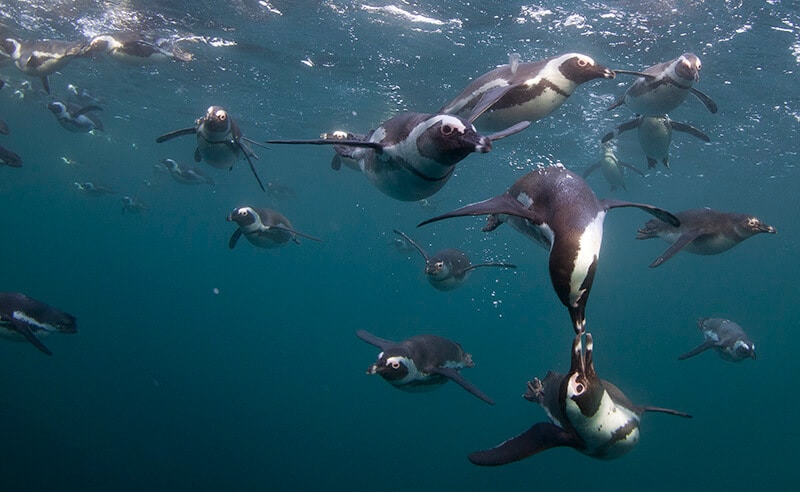 This is the only penguin species that breeds and is regularly seen anywhere in Africa.
This is the only penguin species that breeds and is regularly seen anywhere in Africa.
Hunting parties numbering 5 to 50 penguins are regularly seen close to the Arc rock and Roman rock area (Roman Rock was South Africa’s first automated light house). These birds are mostly from Boulders Beach Penguin Colony which presently holds around 3000 birds.
Seal Island also has a small breeding population which can be most easily seen mid-way up the Eastern side of the island. These penguins can travel 50km or more to feed and are occasionally killed but seldom consumed by Great white sharks.
Sula capensis
 As youngsters these birds are mostly a grey black but by 3-4 years of age turn into brilliant white adults. These large white birds with yellowish wings and spectacularly blue ringed eyes are always special to see if you can get close enough. Known in Afrikaans as “malgans” (mad goose) they are often seen diving kamikaze style from prodigious heights into the sea to catch fish.
As youngsters these birds are mostly a grey black but by 3-4 years of age turn into brilliant white adults. These large white birds with yellowish wings and spectacularly blue ringed eyes are always special to see if you can get close enough. Known in Afrikaans as “malgans” (mad goose) they are often seen diving kamikaze style from prodigious heights into the sea to catch fish.
They enter the water at speeds up to 145 km/hr and reach depths of 30m resurfacing up to 20 seconds later. With almost front facing eyes, they can see forward better than most other birds with near binocular vision.
In part due to this amazing binocular vision, most eventually die blind, from starvation. The repeated lifetime of high-speed impact with the water eventually causes them to lose their eyesight, at least to a point where they can no longer hunt in this way.
Bird Vision
Of interest to many is how birds are able to see so well both above and below the water. Seabirds such as terns and gulls that feed at the surface or plunge for food have red oil droplets in their cones and retinas. This improves contrast and sharpens distance vision, especially in hazy conditions. Birds that have to look through an air/water interface have more deeply coloured carotenoid pigments in the oil drops than other species. This helps them to locate shoals of fish, although it is uncertain whether they are sighting the phytoplankton on which the fish feed, or other feeding birds.
Birds that pursue fish under water like auks and divers have far fewer red oil droplets, but they have special flexible lenses and use the nictitating membrane as an additional lens. This allows greater optical accommodation for good vision in air and water. Cormorants have a greater range of visual accommodation, at 50 dioptres, than any other bird, but the kingfishers are considered to have the best all-round (air and water) vision.
Phalacrocorax capensis
This species is the most abundant and can be often seen leaving in a swirling mass numbering in the thousands. These birds can easily be identified by the yellow throat patch and smaller size than the other two species.
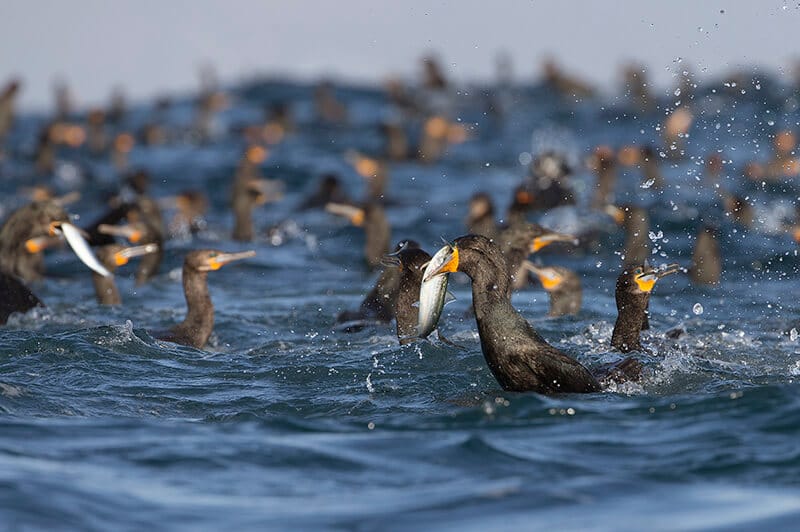
Phalacrocorax carbo
This is South Africa’s largest cormorant and is characterized by a large white breast. Closer inspection reveals two beautiful dark green eyes.
Numerically this cormorant is the least abundant on this island and also the only species which feeds to a large extent around the island. Not surprisingly it is also the bird species which most commonly are attacked by the Great white sharks which upon tasting the bird release it as an unwanted meal in most instances.

Larus dominicanus
These gangsters of the Island will often be seen scavenging on or around the Island. Have a look out on the South Western end of Seal Island where during the months of May to August large numbers congregate. This area dubbed “The Gallery” is the best vantage point for the gulls to watch out for predatory events and during high predation periods up to 50 birds may be seen waiting here.
The mature birds + 4 years are characterized by a red dot on their beaks. The chicks peck this dot which prompts the adults to regurgitate food upon which they then feed.
In January of 2009 we found a sick adult bird drifting close to shore. The ring on the bird’s leg revealed that it was 22 years of age and ringed only two kilometres away from where we found it.
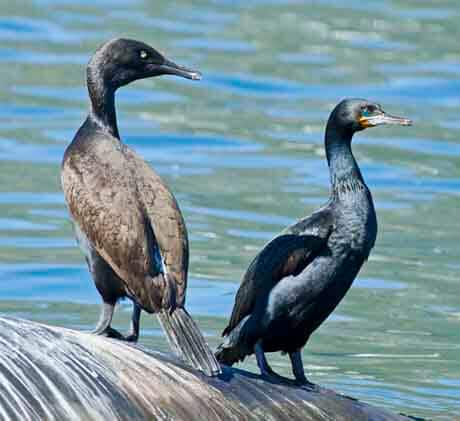
 The waters off Cape Point rank along with New Zealand and Patagonia as the best spots on earth to see the great open ocean birds in a day trip from land. Whilst we wait for the sharks you will have an excellent chance to see many of these birds up close.
The waters off Cape Point rank along with New Zealand and Patagonia as the best spots on earth to see the great open ocean birds in a day trip from land. Whilst we wait for the sharks you will have an excellent chance to see many of these birds up close.
Cape Point’s nutrient rich waters offer the chance to see no less than 7 species of albatross on a single outing although 3-4 is normal. This array includes three species, the Wandering, Northern and Southern albatross which have the largest wingspans of any bird. The greatest of them all is the Wandering Albatross whose wingspan may reach a staggering width of 3.6 meter (11ft).
During our daily excursions we often investigate the wakes of commercial trawlers who ply their trade close to where we work. These boats are trawling the ocean for a species of fish locally known as hake (Merluccius paradoxus) and in the wash of these boats up to 8000 birds can be seen during Autumn and Spring months, one of the greatest gatherings seen anywhere on earth.
Sadly as with long lining, trawling takes a huge toll on sea birds and many species populations are plummeting as a result of mortality due to these fisheries. Hopefully behind the trawlers you will see Tori lines (lines draped off the main net hauling cables) that reduce the amount of birds that collide with the cables.
In addition to thousands of Albatross, petrels, shearwaters, prions, gulls, skuas terns, gannets and a host of rarities and vagrants are regularly seen.
In fact you will have the chance to see the bird with the world’s largest wingspan, the albatross alongside the marine bird with arguably the smallest wingspan, the Storm petrel.
The birds are often less than a few meters away and this is an excellent opportunity to see their amazing adaptations to this extreme environment up close.
The variation in species diversity depends heavily on seasons so be sure to ask beforehand, which is the best time of year to see your special bird.
Seal Island is 400m long and 80 m wide and lies in a roughly North South orientation. This island is home to Africa’s largest island bound seal colony numbering around 64 000 Cape fur Seals.
Arctocephalus pusillus pusillus

The seals use this island as a base and breeding ground and each year around 12 000 pups are born in November and December. The pups are suckled for nine months or more but will start feeding on their own from as early as 5 months with 7 to 8months being more common.
Adult males, or bull seals, return to the island in large numbers to mate and set up territories around September/October each year and then leave shortly after the bulk of pupping by mid-December. These huge seals can weigh over 300kg while a large female may weigh upwards of 75kg.
Ironically this largest of all fur seals was given the scientific name pusillus as it was first described from a pup. Pusillus means small. At birth they weigh around 5-7kg. Males can live for 18 years and females up to 21 years. They are typically seen in False Bay in groups ranging from 1 to 5 animals but can be in large pods numbering over 100 when feeding. Most of these seals will be from Seal Island so you will see many more when we arrive at the Island. They often depart from the Southern end of the island in well organized groups. On the island be sure to look out for seals that are scratching. These seals actually have fleas which are annoyingly moving around in their fur. There is a layer of air under the fur that repels water but also gives the fleas a warm watertight home. If we haven’t been paid a visit by the local seals in the harbour keep a look out along the way.
TOMORROW
Tuesday
27 June 2023
Next trip 28 June
11h45
*Trip status updated daily at 16h00 SAST